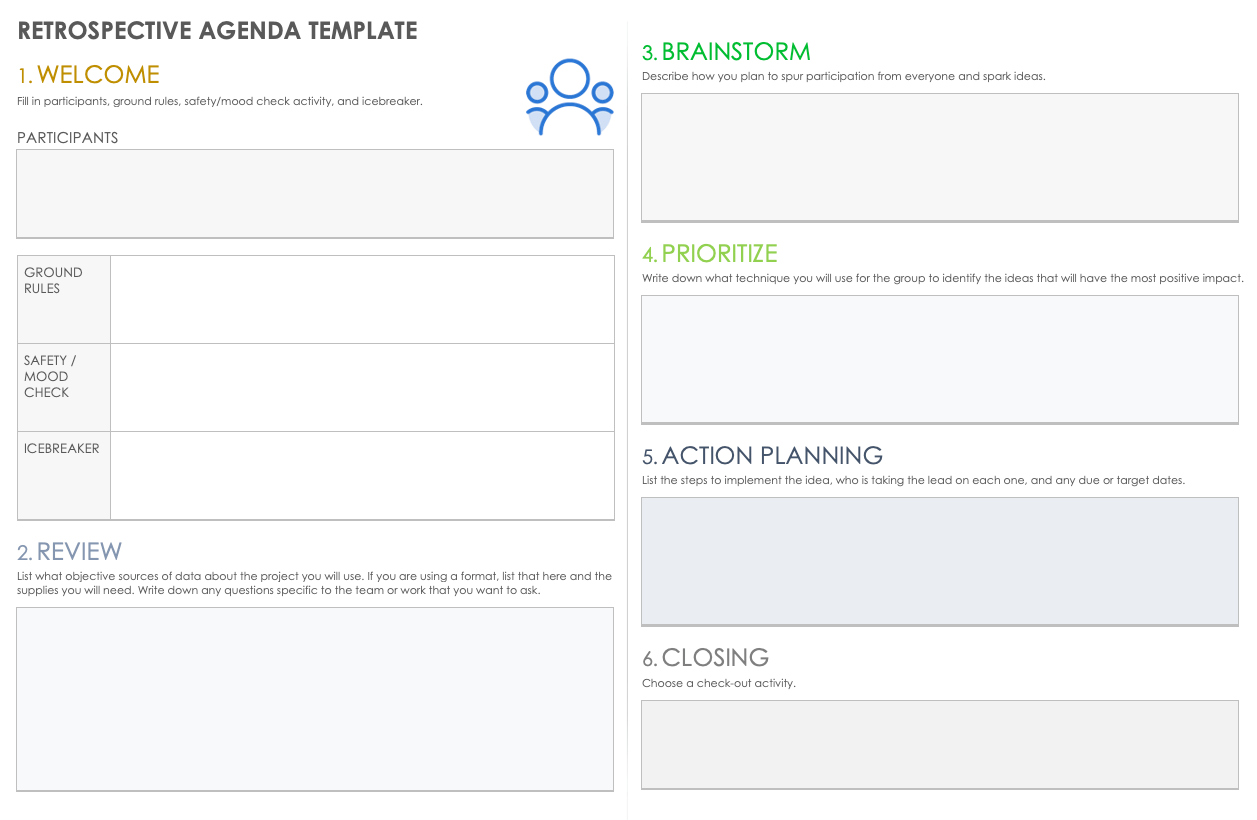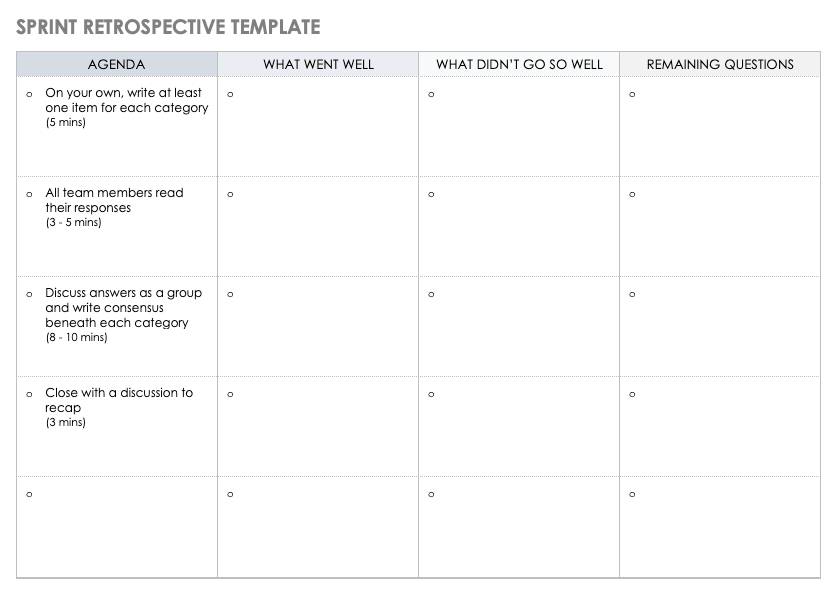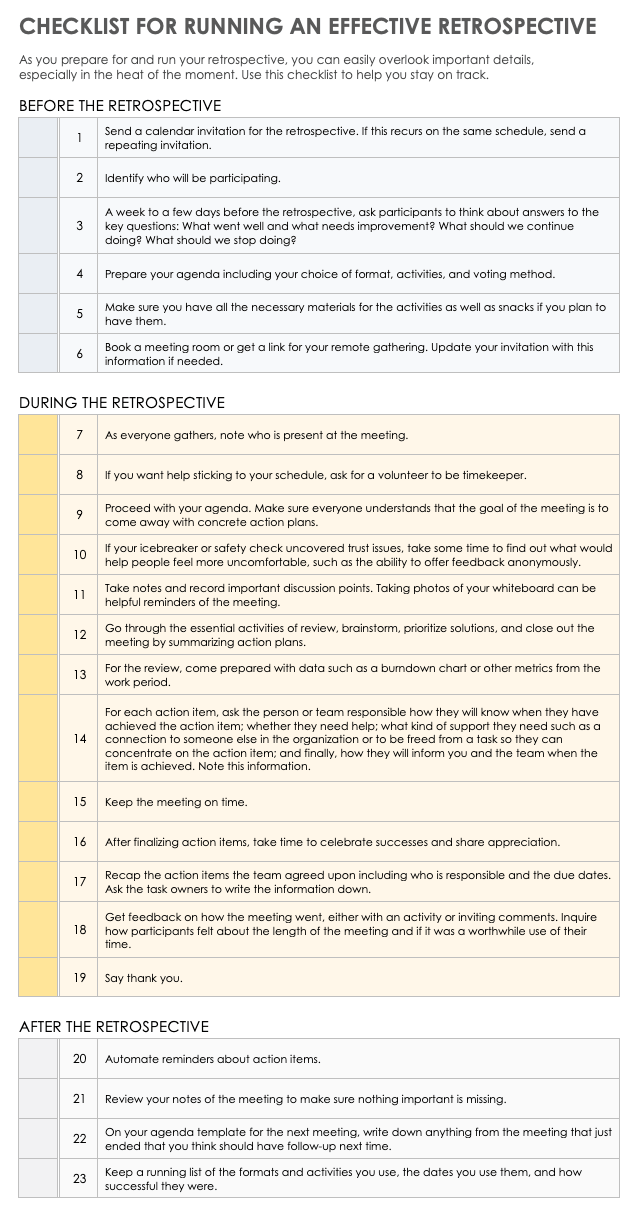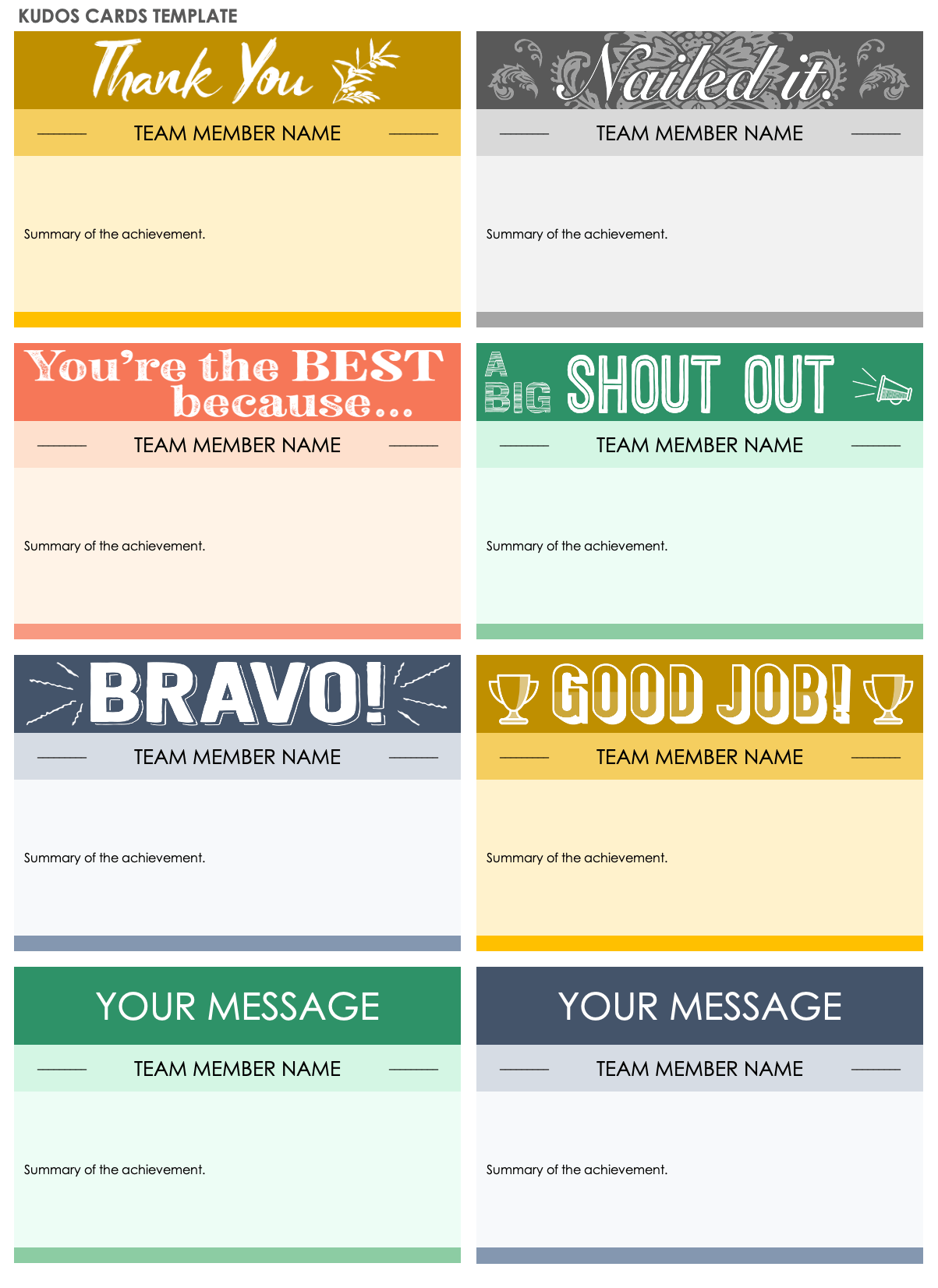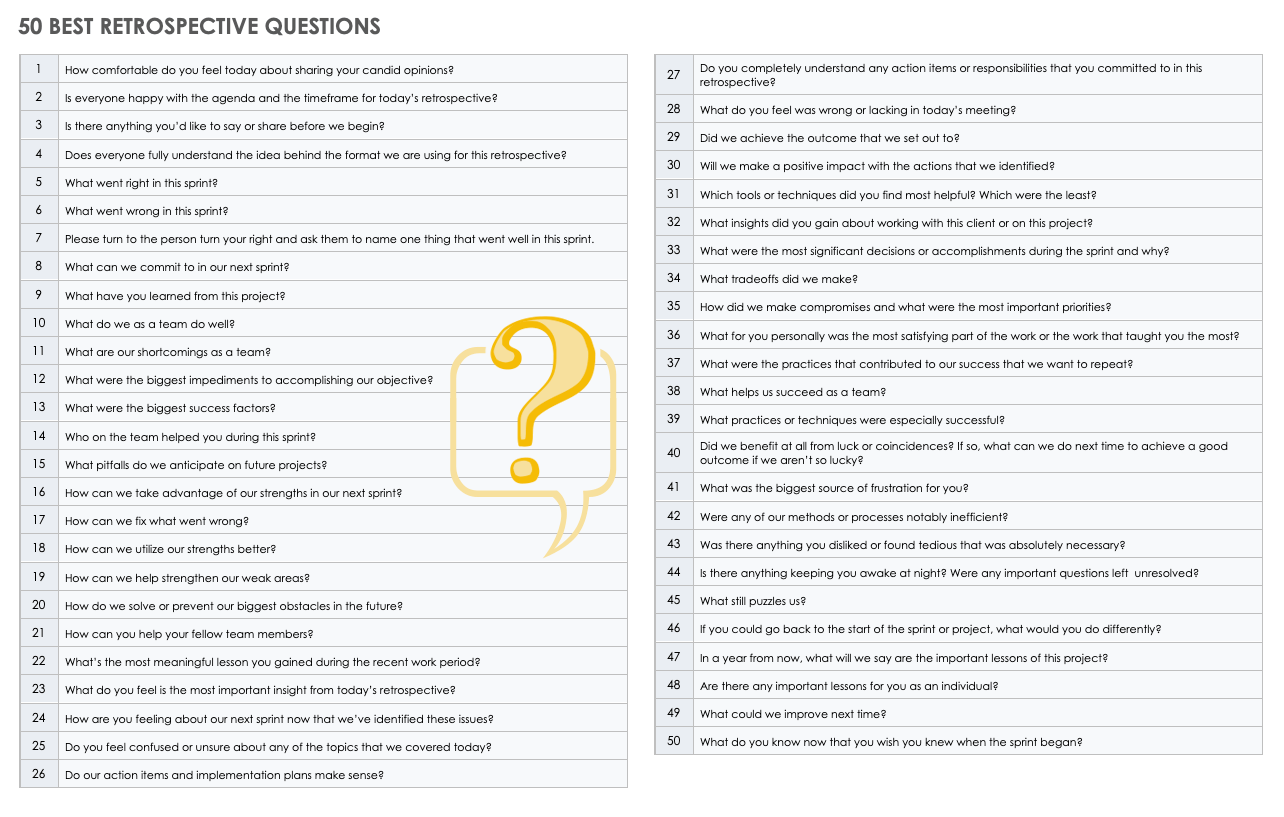What Is a Project Retrospective?
A project retrospective is a structured meeting for a team to review, reflect on, and learn from their work on a project. This exercise can occur during and at the end of a project, and it’s part of the Agile framework of project management, which strives for continuous improvement.
In technical fields, where Agile arose, the retrospective usually takes place after every sprint, a two-week period during which the team tackles a predetermined body of work such as writing software code for certain features. To learn more about Agile, see “The Comprehensive Guide to Agile Project Management.”
However, Agile has spread to other verticals, including marketing, engineering, construction, and pharmaceuticals. In these fields, a retrospective may focus on how a specific project is performing and may occur on a time interval (similar to every two weeks of a sprint), or at milestones and phases (such as once the content calendar is complete, before writing assignments begin).
How Do You Facilitate a Project Retrospective?
In order to be a worthwhile investment of everyone’s time, a retrospective takes planning. This process involves picking a format, identifying other activities that you want (such as an icebreaker), and deciding how the group will vote in the meeting.
The steps below will help you prepare for your retrospective:
- Reflect: Before the retrospective, identify who will participate in the meeting and ask them to think about the recent work period. What should the team stop or start doing? What did the team learn?
- Think About the Environment: Consider your team and the context for the meeting, and plan around what will best suit the conditions. If you are gathering remotely, look at the ideas and suggestions in “17 Activities for Remote and Distributed Retrospective Meetings.” Icebreakers are especially important for new teams.
- Timebox the Meeting: Set a start and end time for the meeting to keep it on track and help participants remain engaged. Midproject and sprint retrospectives should typically last no more than an hour. A good rule of thumb is 30 minutes for each week of work. The suggested time allotments in this article are based on a one-hour meeting, though some teams prefer to standardize on a half-hour.
- Draft an Agenda: Think about each part of the retrospective and how you will handle it. In their influential book Agile Retrospectives: Making Good Teams Great, authors Diana Larsen, Esther Derby, and Ken Schwaber break down the retrospective agenda into phases as described below:
- Set the Stage (10 minutes): Consider your words of welcome. You want to put participants at ease and prime them for open and respectful discussion. At the beginning of the meeting, go over any ground rules, such as Norm Kerth’s Prime Directive, an agreement in which everyone believes all participants did the best job they could. This instills the idea of a “blameless” retrospective. Do a safety or mood check activity and an icebreaker.
- Review (20 minutes): At this stage, gather information on the project work. Use objective sources of data, such as a burndown chart , a Kanban board, and a project timeline. Your format will often direct how you elicit this information. Ask the following key questions: What is working well? What needs improvement? What did we learn? Which project objectives were met, exceeded, or not achieved? What are our biggest challenges?
- Brainstorm (10 minutes): Again, your format may dictate how you present this process. In your agenda, specify how you will elicit strong participation and a free flow of suggestions.
- Prioritize (5 minutes): Choose one of the many activities for the group to winnow down the list of suggestions into two or three action items that will be most effective at addressing the challenges identified earlier.
- Action Planning (10 minutes): Have the group designate people who are accountable for each action item and set dates for implementation. In the agenda, give thought to how you will ensure that participants don’t forget their tasks after the meeting, such as by having people write notes for themselves, schedule email reminders, and post the plan where everyone will see it.
- Closing (5 minutes): Recap the meeting and run an activity that gathers feedback from participants about the retrospective itself, such as choosing an emoji, marking their feelings on a continuum between amazing and disappointing, or dropping a colored card in a basket (red for not a good use of time, yellow for OK, and green for worthwhile).
Retrospective Agenda Template
Use the project retrospective agenda template below to make notes for each step. Each section has spaces where you can fill in information about how you will run that part of the meeting.
Download Retrospective Agenda Template
Download a Retrospective Facilitation Starter Kit
To simplify facilitating a retrospective, download the complete starter kit below. It contains a retrospective agenda template, a sprint retrospective template, a meeting checklist, sample meeting questions, and a template for kudos cards, which provide a handy format for sharing appreciation and recognition of team members.
General Overview of a Project Retrospective
A retrospective uses a straightforward structure. The most important aspects to establish are to ensure that everyone feels safe to express their opinions, the guided discussion addresses the important questions, and the team ends the meeting with a clear list of action items. Remember, the retrospective enables you to analyze the team’s process and practices, not individual performance or the project concept.
These are the primary phases of a retrospective:
- Welcome: Explain the ground rules and make sure everyone understands how the meeting will run.
- Icebreaker: While this phase is optional, when you hold an icebreaker, you often help people feel more comfortable.
- Review: Participants express how the work went, which practices were helpful, and what needs improvement. Learn how to frame the discussion around a particular format or series of questions in “110 Agile Games, Ideas, and Activities for Superb Retrospectives.”
- Brainstorm: Think of ways to address problems and improve the team’s work process.
- Prioritize: Determine which ideas will have the most impact, and commit to them.
- Action Items: Focus on the top two or three ideas that the team can implement right away.
- Conclusion: Check to see how people feel about the meeting: Was it productive and enjoyable?
How to Run a Sprint Retrospective
Once you’ve laid the foundation for a productive retrospective with your agenda, you have to run the project retrospective itself. As the retrospective advances, be prepared to address common issues, including teammates not speaking up, one person dominating the conversation, and the team committing to too many action items.
A sprint retrospective focuses on a time-defined body of work, typically two weeks in the high-tech world. A project retrospective may also be concerned with a time-defined segment of work, but it may instead focus on work by milestone or phase, rather than period of time. That said, the substance of a project retrospective and sprint retrospective is the same.
To run a good retrospective, follow your agenda and conduct the following steps in order:
1. Welcome: Greet participants, and explain the ground rules, especially if there are new team members or people new to retrospectives. Consider holding an icebreaker to help people feel more comfortable, a mood check to gauge the team’s temperament, or a safety assessment that explores whether participants feel safe expressing their honest opinions.
2. Review: Recap what the team accomplished, and cite specifics. Also list any scheduled work that members did not finish. Ask team members to identify successes, challenges, and obstacles, and discuss insights and lessons learned. At this time, apply your project retrospective idea or format, if you are using one. Team members can note their input on sticky notes that go on a whiteboard, marking on a whiteboard, using index cards, or entering information in an online tool.
Download this sprint retrospective template, and use it to record details on what went well and what did not. You can use this sheet to summarize group input, or give each participant a copy to make notes for contributing to the discussion.
Download Sprint Retrospective Template
3. Brainstorm: Solicit ideas for solving problems and embedding helpful practices. Ensure everyone has a chance to contribute. Record all suggestions.
4. Prioritize: Use an activity, such as voting, to narrow down the list of suggestions to three or fewer ideas that, when implemented, will have the biggest impact.
5. Action Planning: Identify actions to put the ideas into operation. Define the steps and procedures to implement these ideas, as well as assign due dates and the individuals responsible.
6. Closing: Recap what occurred in the meeting and the next steps. Seek feedback from participants on how useful they found the retrospective, or go with another closing activity. Record notes or minutes and the retrospective format you used so you can refer back. These records are helpful for seeing how many times team members raise the same issue and for making sure you don’t reuse the same format too often.
Checklist for Running an Effective Retrospective
Download Running an Effective Retrospective Checklist
Microsoft Word | Adobe PDF | Google Docs | Smartsheet
As you prepare for and run your retrospective, you can easily overlook important details, especially in the heat of the moment. Use this checklist to help you stay on track.
Before the Retrospective
1. Send a calendar invitation for the retrospective. If you plan to run a retrospective on a certain frequency, send a repeating invitation.
2. Identify the team members who will participate.
3. A week to a few days before the retrospective, ask participants to think about answers to the key questions: What went well? What needs improvement? What should we continue doing? What should we stop doing?
4. Prepare your agenda, including your choice of format, activities, and voting method.
5. Make sure you have all the necessary materials for the activities, as well as snacks if you plan to serve them.
6. Book a meeting room or get a link for your remote gathering. Update your invitation with this information, if necessary.
During the Retrospective
7. As everyone gathers, note who is present at the meeting.
8. If you want help sticking to your schedule, ask for a volunteer to act as the timekeeper.
9. Proceed with your agenda. Make sure everyone understands that the goal of the meeting is to come away with concrete action plans.
10. If you uncovered trust issues during your icebreaker or safety check, take some time to find out what would help people feel more comfortable, such as the ability to offer feedback anonymously.
11. Take notes and record important discussion points. Photos of your whiteboard can also serve as helpful reminders later on.
12. Go through the essential activities of reviewing, brainstorming, prioritizing solutions, and closing out the meeting by summarizing action plans.
13. For the review, come prepared with data, such as a burndown chart or other metrics from the work period.
14. For each action item, ask the person or team responsible to explain how they will know when they have achieved the action item. Also ask if they need help; what kind of support they need (such as a connection to someone in the organization or their release from a task so they can concentrate on the action item); and finally, how they will inform you and the team when the item is achieved. Note this information.
15. Keep the meeting on time.
16. After finalizing action items, take time to celebrate successes and share appreciation.
Tips for Improving Your Sprint Retrospective and Preventing Boredom
As your team holds more retrospectives and you gain more experience running a retrospective, the meetings will become more productive. Below, we’ve compiled tips to the most out of these events:
1. Make Sure Everyone Gets Air Time: In your opening, check the mood and the team’s sense of safety. If you suspect that someone does not feel comfortable being honest, hold an icebreaker or other activity to promote trust (remember that this is a long-term process). Also consider soliciting feedback anonymously in writing.
To help mitigate this discomfort, remind people ahead of the meeting what they will discuss and ask them to prepare by thinking about the key topics. This will help less talkative colleagues be ready to contribute.
If you have dominating personalities on the team, keep them from taking over by going around the room in order. If the meeting is a remote/in-person hybrid, take special care to keep the groups on equal footing, so that you don’t let in-person participants focus solely on each other.
Lastly, remember not to talk too much yourself or direct the outcome toward certain conclusions. Your role is to lead the group in self discovery.
2. Stick to Time Limits: Keep track of how long you spend on an activity or agenda section, and do not go over the allotted time. If that is hard for you to do while running the meeting, appoint someone to be a timekeeper. If the retrospective runs over time, participants’ attention will wander.
It’s important that all participants feel their time has been respected and well spent, as rambling on or letting the meeting lose structure will weaken team support for the retrospective process.
3. Keep the Tone Constructive: In the welcome phase, go over the baseline expectations for the meeting, such as that no one will blame another or make personal criticisms. If interpersonal relationships have been rocky on the team, address that tension before the retrospective with the individuals involved. Keep the discussion in the meeting focused on team processes and practices, rather than on personalities or individual shortcomings. If the conversation starts to devolve into blaming, realign the group with the ground rules immediately.
4. Do Not Give Short Shrift to Successes: People often assume that since the retrospective is a key tool in continuous improvement, the meeting should only cover what needs improving. That is a mistake.
Recounting triumphs and allowing team members to recognize one another with thanks and appreciation can be very motivating. You can download the kudos cards template below to foster that practice, which you can use digitally or print out and share. They provide a space to write details about the reason for the kudos and the name of the person being recognized.
Download Kudos Cards Template Adobe
Microsoft Excel | Microsoft Word | Adobe PDF
Moreover, the retrospective strives to uncover what is going well and what the team should do more. Calling out these practices will help you become aware of the success factors.
5. Be Realistic: Enthusiastic teams and facilitators often get caught in the trap of taking on too many action items or being overly ambitious, which defeats the purpose.
Continuous improvement is about incremental, cumulative changes. If the team takes on too much at once, everything will likely not get done. That inconsistency weakens your process. With too much on the action list, efforts to implement the items can also crowd out primary work and negatively impact the project.
Action items that are too ambitious can be disruptive. If you ask people to make huge changes in the way they work, adaptation becomes challenging, and things that were working previously may fall apart. Break down ambitious steps into smaller pieces that the team can implement over time.
6. Be Action-Oriented: Make sure the meeting ends with actionable ideas that have owners and due dates. Plan how the team will keep these actions top of mind, whether with reminder emails, calendar notifications, or signs by the coffeemaker.
You can find even more tips for improving your retrospective meeting in our comprehensive guide.
What Do You Say in a Retrospective Meeting?
One of the retrospective facilitator’s most important but challenging responsibilities is prompting team members to identify areas that need improvement. The best way to do this is by asking thought-provoking questions.
Sometimes, participants feel like their minds are blank. This can occur because the same format has been used repeatedly and no longer prompts meaningful reflection. Alternatively, people may be so accustomed to certain issues and inefficiencies that they no longer see them. Or you may be rushing the retrospective, so team members do not have enough time. Lastly, if your team does not implement action items consistently, participants may lose faith in the retrospective process and disengage.
50 Best Retrospective Questions
Here are 50 of the best questions to ask in retrospectives, designed to elicit meaningful thoughts and avoid rote responses. Remember to leave silence, rather than talking through any awkward pauses. Doing so gives participants an opportunity to speak and contribute.
As you gain experience running a sprint retrospective, you’ll find that your most important role is to get team members talking, often by asking good questions.
- How comfortable do you feel today about sharing your candid opinions?
- Is everyone happy with the agenda and the timeframe for today’s retrospective?
- Is there anything you’d like to say or share before we begin?
- Does everyone fully understand the idea behind the format we are using for this retrospective?
- What went well in this sprint?
- What went wrong in this sprint?
- Please turn to the person to your right and ask them to name one thing that went well in this sprint.
- What can we commit to in our next sprint?
- What have you learned from this project?
- What do we as a team do well?
- What are our shortcomings as a team?
- What were the biggest impediments to accomplishing our objective?
- What were the biggest success factors?
- Who on the team helped you during this sprint?
- What pitfalls do we anticipate on future projects?
- How can we take advantage of our strengths in our next sprint?
- How can we fix what went wrong?
- How can we utilize our strengths better?
- How can we help strengthen our weak areas?
- How do we solve or prevent our biggest obstacles in the future?
- How can you help your fellow team members?
- What’s the most meaningful lesson you gained during the recent work period?
- What do you feel is the most important insight from today’s retrospective?
- How are you feeling about our next sprint now that we’ve identified these issues?
- Do you feel confused or unsure about any of the topics that we covered today?
- Do our action items and implementation plans make sense?
- Do you completely understand any action items or responsibilities that you committed to in this retrospective?
- What do you feel was wrong or lacking in today’s meeting?
- Did we reach the outcome that we set out to achieve?
- Will we make a positive impact with the actions that we identified?
- Which tools or techniques did you find most helpful? Which were the least helpful?
- What insights did you gain about working with this client or on this project?
- What were the most significant decisions or accomplishments during the sprint and why?
- What trade-offs did we make?
- How did we make compromises and what were the most important priorities?
- What for you personally was the most satisfying part of the work, or what was the work that taught you the most?
- What were the practices that contributed to our success that we want to repeat?
- What helps us succeed as a team?
- What practices or techniques were especially successful?
- Did we benefit at all from luck or coincidences? If so, what can we do next time to achieve a good outcome if we aren’t so lucky?
- What was the biggest source of frustration for you?
- Were any of our methods or processes notably inefficient?
- Was there anything you disliked or found tedious that was absolutely necessary?
- Is there anything keeping you awake at night? Were any important questions left unresolved?
- What still puzzles us?
- If you could go back to the start of the sprint or project, what would you do differently?
- In a year from now, what will we say are the important lessons of this project?
- Are there any important lessons for you as an individual?
- What could we improve next time?
- What do you know now that you wish you knew when the sprint began?
Download 50 Best Questions to Ask in a Retrospective
How Retrospective Tools Help Make Project Retrospectives More Successful
Online tools can help support your sprint retrospectives, and they offer several advantages that help foster a more productive and efficient meeting. You can also use purpose-built tools, as well as electronic whiteboards that support retrospectives.
You can learn more about several of these tools in “Effective Remote Retrospective Tools.” Online tools can also help you learn how to run a retrospective online.
These tools can help you in a variety of ways, including the following:
- Digital tools make it easier for remote team members to participate, and they put remote and in-person attendees on equal footing.
- Many tools offer templates for popular retrospective formats, which saves the facilitator the task of drawing boards.
- Retrospective tools often make it easier for people to submit comments and contributions anonymously, which may open more honest conversations.
- Voting and other procedures happen with a single click. The tool typically has features to handle these processes.
- Using a retrospective tool often makes it easy to turn ideas into action steps and to automate reminders. Similarly, the tool can automatically send people questions to think about in the days leading up to the next retrospective.
- Online platforms store records and notes from past retrospectives and can allow you to see trends in answers to questions over time, such as engagement with the meeting or sense of safety.
Get the Most out of Your Retrospective with Real-Time Work Management in Smartsheet
Empower your people to go above and beyond with a flexible platform designed to match the needs of your team — and adapt as those needs change.
The Smartsheet platform makes it easy to plan, capture, manage, and report on work from anywhere, helping your team be more effective and get more done. Report on key metrics and get real-time visibility into work as it happens with roll-up reports, dashboards, and automated workflows built to keep your team connected and informed.
When teams have clarity into the work getting done, there’s no telling how much more they can accomplish in the same amount of time. Try Smartsheet for free, today.
